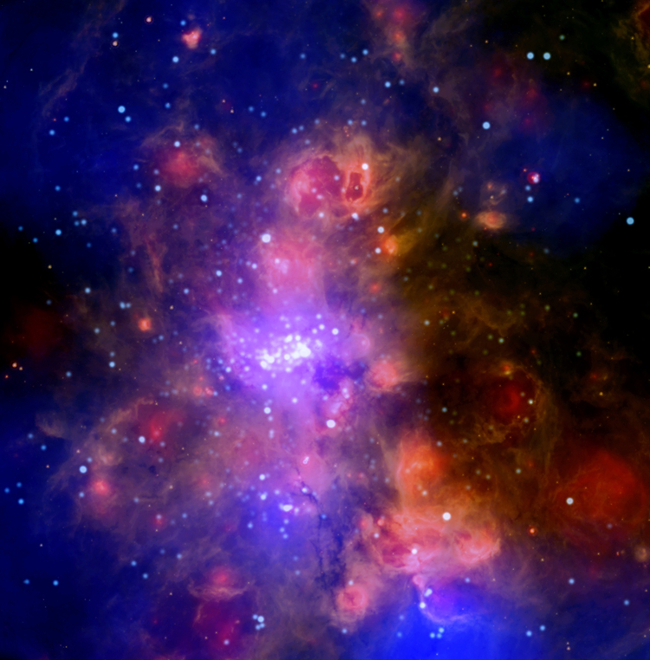
 Credit: X-ray: NASA/CXC/PSU/L.Townsley et al; Infrared: NASA/JPL-Caltech
Credit: X-ray: NASA/CXC/PSU/L.Townsley et al; Infrared: NASA/JPL-Caltech
Feeding Back
Star formation is a very dynamic process. Stars form out of thick clouds composed primarily of hydrogen and helium, where densities are so high some portion of the hydrogen atoms, and other trace atoms of carbon and oxygen, have combined to form molecules of diatomic hydrogen, carbon monoxide, carbon dioxide, steam, and solid particles of dust. Since the density of gas in the cloud varies from place to place, the densest locations will have a bit more
gravitational pull than the less dense region nearby, attracting more gas and dust and becoming even denser. Through this relatively slow process tiny nuggets of matter grow into stars. Once stars form, however, they change the character of their birth cloud through radiation and by stellar winds, a process astronomers call feedback. The image above documents a snapshot of this process, showing high energy X-ray emission (in blue) and infrared emission (in yellow-orange) of the giant molecular cloud called W51. The X-ray emission (from observations with the Chandra X-ray Observatory) originates from hot shocked gas produced by strong mass outflows from massive stars, and from magnetically-driven activity from low mass stars. The outflows, and the powerful X-ray emission, along with strong ultraviolet emission from the stars themselves, creates low-density bubbles of ionized gas in the molecular cloud near the newly-formed stars. The infrared emission (observed by the Spitzer Space Telescope) shows emission from dust heated by the stars, and details the high density, cooler regions of the molecular cloud. Regions where diffuse X-ray emission is faint are often regions where the infrared emission is bright, indicating that either these regions are shielded from the disruptive radiation of the young stars, or that these regions are dense enough to block X-ray emission from these regions.
Published: July 24, 2017
<
HEA Dictionary ● Archive
● Search HEAPOW
● Other Languages
● HEAPOW on Facebook
● Download all Images
● Education ● HEAD
>

Each week the HEASARC
brings you new, exciting and beautiful images from X-ray and Gamma ray
astronomy. Check back each week and be sure to check out the HEAPOW archive!
Page Author: Dr. Michael F. Corcoran
Last modified Monday, 26-Feb-2024 17:47:50 EST


